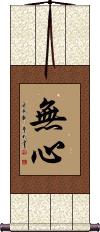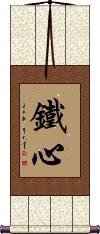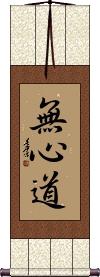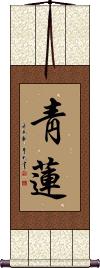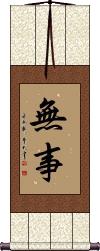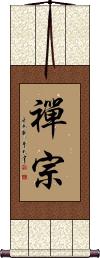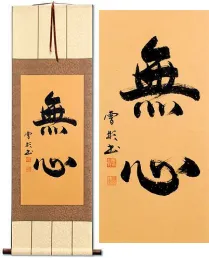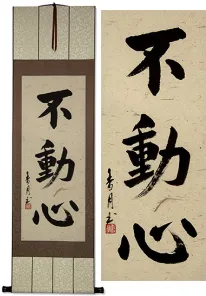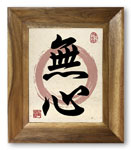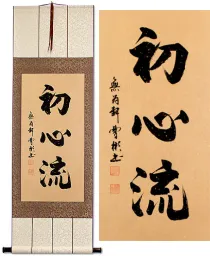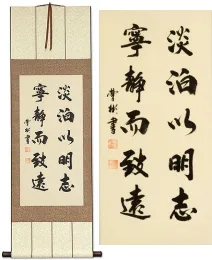Many custom options...
And formats...

Without Mind in Chinese / Japanese...
Buy a Without Mind calligraphy wall scroll here!
Personalize your custom “Without Mind” project by clicking the button next to your favorite “Without Mind” title below...
No Mind / Mushin
In Japanese, 無心 means innocent or without knowledge of good and evil. It literally means “without mind.”
無心 is one of the five spirits of the warrior (budo) and is often used as a Japanese martial arts tenet. Under that context, places such as the Budo Dojo define it this way: “No mind, a mind without ego. A mind like a mirror which reflects and dos not judge.” The original term was “mushin no shin,” meaning “mind of no mind.” It is a state of mind without fear, anger, or anxiety. Mushin is often described by the phrase “Mizu no Kokoro,” which means “mind like water.” The phrase is a metaphor describing the pond that clearly reflects its surroundings when calm but whose images are obscured once a pebble is dropped into its waters.
This has a good meaning in conjunction with Chan / Zen Buddhism in Japan. However, out of that context, it means mindlessness or absent-mindedness. To non-Buddhists in China, this is associated with doing something without thinking.
In Korean, this usually means indifference.
Use caution and know your audience before ordering this selection.
More info: Wikipedia: Mushin
Open and Calm Mind
虛心坦懐 is a Japanese proverb that means “with an open and calm mind,” “with no preconceived notions,” or “without reservations.”
In some contexts, it can mean frank or candid.
If you want to remind yourself to approach each situation with no preconceptions, this is a good title for you. This can also refer to the ideas of being candid, frank, and straightforward.
Iron Heart
鐵心 can be translated as “iron heart,” “steel core,” or “iron mind” in Chinese and Japanese Kanji.
This is not a common term, but I added it here since so many were looking for “iron heart.” This is almost like saying you are without emotions or feelings - a very stoic person. This is not a Buddhist trait.
Mushindo
Blue Lotus
靑蓮 is a common title for Blue Lotus.
靑蓮 is often used in a Buddhist context for blue lotus from the Sanskrit “utpala.” This often refers to the clarity and purity of the lotus blue eyes possessed by a Living Buddha. It can also represent the purity of mind (without desire, suffering, fear, etc.).
No Trouble / Freedom from Problems
無事 is a Zen Buddhist term meaning no problem and no trouble.
無事 is the Zen state of perfect freedom from troubles and leaving secular affairs behind.
Sometimes this is used to describe the state of satori and complete tranquility of mind.
Written as 無事に with an extra Hiragana at the end, this becomes an adverb to describe something in the condition of safety, peace, quietness, and without troubles.
無事 (Buji) can also be a given name in Japan.
This has more meaning in the Japanese Zen Buddhist community than in China or Korea, where it can mean “be free” or “nothing to do or worry about.”
Zen Buddhism
禪宗 is one way to title “Zen Buddhism.” Because the original pronunciation of Zen in Chinese is Chan, you'll also see this expressed as Chan Buddhism.
From the Buddhist Dictionary:
The Chan, meditative or intuitional, sect is usually said to have been established in China by Bodhidharma, the twenty-eighth patriarch, who brought the tradition of the Buddha-mind from India. This sect, believing in direct enlightenment, disregarded ritual and sūtras and depended upon the inner light and personal influence for the propagation of its tenets, founding itself on the esoteric tradition supposed to have been imparted to Kāśyapa by the Buddha, who indicated his meaning by plucking a flower without further explanation. Kāśyapa smiled in apprehension and is supposed to have passed on this mystic method to the patriarchs. The successor of Bodhidharma was 慧可 Huike, and he was succeeded by 僧璨 Sengcan, 道信 Daoxin, 弘忍 Hongren, 慧能 Huineng, and 神秀 Shenxiu, the sect dividing under the two latter into the southern and northern schools: the southern school became prominent, producing 南嶽 Nanyue and 靑原 Qingyuan, the former succeeded by 馬祖 Mazu, the latter by 石頭 Shitou. From Mazu's school arose the five later schools.
This in-stock artwork might be what you are looking for, and ships right away...
Gallery Price: $202.00
Your Price: $111.88
Gallery Price: $106.00
Your Price: $58.88
Gallery Price: $79.00
Your Price: $43.88
Gallery Price: $202.00
Your Price: $111.88
Gallery Price: $79.00
Your Price: $43.88
Gallery Price: $200.00
Your Price: $118.88
Gallery Price: $200.00
Your Price: $118.88
Gallery Price: $168.00
Your Price: $92.88
Gallery Price: $79.00
Your Price: $43.88
Gallery Price: $168.00
Your Price: $92.88
Gallery Price: $168.00
Your Price: $92.88
Gallery Price: $198.00
Your Price: $109.88
Not the results for without mind that you were looking for?
Below are some entries from our dictionary that may match your without mind search...
| Characters If shown, 2nd row is Simp. Chinese |
Pronunciation Romanization |
Simple Dictionary Definition |
空 see styles |
kòng kong4 k`ung kung kuu / ku くう |
More info & calligraphy: Sky / Ether / Void / Emptiness / Unreality(1) empty air; sky; (2) {Buddh} shunyata (the lack of an immutable intrinsic nature within any phenomenon); emptiness; (3) (abbreviation) (See 空軍) air force; (noun or adjectival noun) (4) fruitlessness; meaninglessness; (noun or adjectival noun) (5) (See 五大・1) void (one of the five elements); (can be adjective with の) (6) {math} empty (e.g. set); (female given name) Ron śūnya, empty, void, hollow, vacant, nonexistent. śūnyatā, 舜若多, vacuity, voidness, emptiness, non-existence, immateriality, perhaps spirituality, unreality, the false or illusory nature of all existence, the seeming 假 being unreal. The doctrine that all phenomena and the ego have no reality, but are composed of a certain number of skandhas or elements, which disintegrate. The void, the sky, space. The universal, the absolute, complete abstraction without relativity. There are classifications into 2, 3, 4, 6, 7, 11, 13, 16, and 18 categories. The doctrine is that all things are compounds, or unstable organisms, possessing no self-essence, i.e. are dependent, or caused, come into existence only to perish. The underlying reality, the principle of eternal relativity, or non-infinity, i.e. śūnya, permeates all phenomena making possible their evolution. From this doctrine the Yogācārya school developed the idea of the permanent reality, which is Essence of Mind, the unknowable noumenon behind all phenomena, the entity void of ideas and phenomena, neither matter nor mind, but the root of both. |
信心 see styles |
xìn xīn xin4 xin1 hsin hsin shinjin しんじん |
More info & calligraphy: Confidence / Faithful Heart(noun, transitive verb) faith; belief; piety; devotion; godliness A believing mind, which receives without doubting.; Great or firm faith in, or surrender to Buddha, especially to Amitabha. |
無心 无心 see styles |
wú xīn wu2 xin1 wu hsin mushin むしん |
More info & calligraphy: No Mind / Mushin(n,adj-no,adj-na) (1) innocence; (noun - becomes adjective with の) (2) {Buddh} (See 有心・2) mind free of obstructive thoughts; detachment; no-mind; (adj-no,n) (3) insentient; (noun, transitive verb) (4) pestering (someone for money, etc.); asking; begging; request Mindless, without thought, will, or purpose; the real immaterial mind free from illusion; unconsciousness, or effortless action. |
禪宗 禅宗 see styles |
chán zōng chan2 zong1 ch`an tsung chan tsung Zenshū |
More info & calligraphy: Zen BuddhismThe Chan, meditative or intuitional, sect usually said to have been established in China by Bodhidharma, v. 達, the twenty-eighth patriarch, who brought the tradition of the Buddha-mind from India. Cf. 楞 13 Laṅkāvatāra sūtra. This sect, believing in direct enlightenment, disregarded ritual and sūtras and depended upon the inner light and personal influence for the propagation of its tenets, founding itself on the esoteric tradition supposed to have been imparted to Kāśyapa by the Buddha, who indicated his meaning by plucking a flower without further explanation. Kāśyapa smiled in apprehension and is supposed to have passed on this mystic method to the patriarchs. The successor of Bodhidharma was 慧可 Huike, and he was succeeded by 僧璨 Sengcan; 道信 Daoxin; 弘忍 Hongren; 慧能 Huineng, and 神秀 Shenxiu, the sect dividing under the two latter into the southern and northern schools: the southern school became prominent, producing 南嶽 Nanyue and 靑原 Qingyuan, the former succeeded by 馬祖 Mazu, the latter by 石頭 Shitou. From Mazu's school arose the five later schools, v. 禪門. |
虚心坦懐 see styles |
kyoshintankai きょしんたんかい |
(yoji) with an open and calm mind; with no preconceived notions; without reserve; frank; candid |
捨 舍 see styles |
shě she3 she sha しゃ |
to give up; to abandon; to give alms {Buddh} equanimity; upeksa; upekkha upekṣā, neglect, indifference, abandoning, M.W. To relinquish, renounce, abandon, reject, give. One of the chief Buddhist virtues, that of renunciation, leading to a state of "indifference without pleasure or pain" (Keith), or independence of both. v. 舍. It is defined as the mind 平等 in equilibrium, i.e. above the distinction of things or persons, of self or others; indifferent, having abandoned the world and all things and having no affections or desires. One of the seven bodhyaṅgas. Translit. sa, śa, s(r). |
三大 see styles |
sān dà san1 da4 san ta sandai さんだい |
(prefix) (See 三大疾病) the big three ...; (surname) Miou The three great characteristics of the 眞如 in the 起信論 Awakening of Faith: (1) 體大 The greatness of the bhūtatathatā in its essence or substance; it is 衆生心之體性 the embodied nature of the mind of all the living, universal, immortal, immutable, eternal; (2) 相大 the greatness of its attributes or manifestations, perfect in wisdom and mercy, and every achievement; (3) 用大 the greatness of its functions and operations within and without, perfectly transforming all the living to good works and good karma now and hereafter. There are other groups, e.g. 體, 宗, and 用. |
五智 see styles |
wǔ zhì wu3 zhi4 wu chih gochi ごち |
(place-name, surname) Gochi The five kinds of wisdom of the 眞言宗 Shingon School. Of the six elements 六大 earth, water, fire, air (or wind), ether (or space) 曇空, and consciousness (or mind 識 ), the first five form the phenomenal world, or Garbhadhātu, the womb of all things 胎藏界, the sixth is the conscious, or perceptive, or wisdom world, the Vajradhātu 金剛界, sometimes called the Diamond realm. The two realms are not originally apart, but one, and there is no consciousness without the other five elements. The sixth element, vijñāna, is further subdivided into five called the 五智 Five Wisdoms: (1) 法界體性智 dharmadhātu-prakṛti-jñāna, derived from the amala-vijñāna, or pure 識; it is the wisdom of the embodied nature of the dharmadhātu, defined as the six elements, and is associated with Vairocana 大日, in the centre, who abides in this samādhi; it also corresponds to the ether 空 element. (2) 大圓鏡智 adarśana-jñāna, the great round mirror wisdom, derived from the ālaya-vijñāna, reflecting all things; corresponds to earth, and is associated with Akṣobhya and the east. (3) 平等性智 samatā-jñāna, derived from mano-vijñāna, wisdom in regard to all things equally and universally; corresponds to fire, and is associated with Ratnasaṃbhava and the south. (4) 妙觀察智 pratyavekṣaṇa-jñāna, derived from 意識, wisdom of profound insight, or discrimination, for exposition and doubt-destruction; corresponds to water, and is associated with Amitābha and the west. (5) 成所作智 kṛtyānuṣṭhāna-jñāna, derived from the five senses, the wisdom of perfecting the double work of self-welfare and the welfare of others; corresponds to air 風 and is associated with Amoghasiddhi and the north. These five Dhyāni-Buddhas are the 五智如來. The five kinds of wisdom are the four belonging to every Buddha, of the exoteric cult, to which the esoteric cult adds the first, pure, all-refecting, universal, all-discerning, and all-perfecting. |
冥合 see styles |
míng hé ming2 he2 ming ho meigō |
to agree implicitly; of one mind; views coincide without a word exchanged to match perfectly |
別傳 别传 see styles |
bié zhuàn bie2 zhuan4 pieh chuan betsuden |
supplementary biography Separately handed down; oral tradition; to pass on the teaching from mind to mind without writing, as in the Chan (Zen) or Intuitional school. Also 單傳. |
四禪 四禅 see styles |
sì chán si4 chan2 ssu ch`an ssu chan shizen |
(四禪天) The four dhyāna heavens, 四靜慮 (四靜慮天), i. e. the division of the eighteen brahmalokas into four dhyānas: the disciple attains to one of these heavens according to the dhyāna he observes: (1) 初禪天 The first region, 'as large as one whole universe' comprises the three heavens, Brahma-pāriṣadya, Brahma-purohita, and Mahābrahma, 梵輔, 梵衆, and 大梵天; the inhabitants are without gustatory or olfactory organs, not needing food, but possess the other four of the six organs. (2) 二禪天 The second region, equal to 'a small chiliocosmos' 小千界, comprises the three heavens, according to Eitel, 'Parīttābha, Apramāṇābha, and Ābhāsvara, ' i. e. 少光 minor light, 無量光 infinite light, and 極光淨 utmost light purity; the inhabitants have ceased to require the five physical organs, possessing only the organ of mind. (3) 三禪天 The third region, equal to 'a middling chiliocosmos '中千界, comprises three heavens; Eitel gives them as Parīttaśubha, Apramāṇaśubha, and Śubhakṛtsna, i. e. 少淨 minor purity, 無量淨 infinite purity, and 徧淨 universal purity; the inhabitants still have the organ of mind and are receptive of great joy. (4) 四禪天 The fourth region, equal to a great chiliocosmos, 大千界, comprises the remaining nine brahmalokas, namely, Puṇyaprasava, Anabhraka, Bṛhatphala, Asañjñisattva, Avṛha, Atapa, Sudṛśa, Sudarśana, and Akaniṣṭha (Eitel). The Chinese titles are 福生 felicitous birth, 無雲 cloudless, 廣果 large fruitage, 無煩 no vexations, atapa is 無熱 no heat, sudṛśa is 善見 beautiful to see, sudarśana is 善現 beautiful appearing, two others are 色究竟 the end of form, and 無想天 the heaven above thought, but it is difficult to trace avṛha and akaniṣṭha; the inhabitants of this fourth region still have mind. The number of the dhyāna heavens differs; the Sarvāstivādins say 16, the 經 or Sutra school 17, and the Sthavirāḥ school 18. Eitel points out that the first dhyāna has one world with one moon, one mem, four continents, and six devalokas; the second dhyāna has 1, 000 times the worlds of the first; the third has 1, 000 times the worlds of the second; the fourth dhyāna has 1, 000 times those of the third. Within a kalpa of destruction 壞劫 the first is destroyed fifty-six times by fire, the second seven by water, the third once by wind, the fourth 'corresponding to a state of absolute indifference' remains 'untouched' by all the other evolutions; when 'fate (天命) comes to an end then the fourth dhyāna may come to an end too, but not sooner'. |
女人 see styles |
nǚ ren nu:3 ren5 nü jen nyonin; jojin にょにん; じょじん |
wife woman Woman, described in the Nirvāṇa sūtra 浬槃經 9 as the "abode of all evil", 一切女人皆是衆惡之所住處 The 智度論 14 says: 大火燒人是猶可近, 淸風無形是亦可捉, 蚖蛇含毒猶亦可觸, 女人之心不可得實 "Fierce fire that would burn men may yet be approached, clear breezes without form may yet be grasped, cobras that harbour poison may yet be touched, but a woman's heart is never to be relied upon." The Buddha ordered Ānanda: "Do not Look at a woman; if you must, then do not talk with her; if you must, then call on the Buddha with all your mind"— an evidently apocryphal statement of 文句 8. |
暗合 see styles |
àn hé an4 he2 an ho angou / ango あんごう |
to agree implicitly; of one mind; views coincide without a word exchanged (n,vs,vi) coincidence |
梵心 see styles |
fàn xīn fan4 xin1 fan hsin bonshin |
The noble or pure mind (which practises the discipline that ensures rebirth in the realm without form). |
無想 无想 see styles |
wú xiǎng wu2 xiang3 wu hsiang musou / muso むそう |
a blank mind; (given name) Musou Without thought, absence of thinking. |
眞如 see styles |
zhēn rú zhen1 ru2 chen ju shinnyo しんにょ |
(surname) Shinnyo bhūtatathatā, 部多多他多. The眞 is intp. as 眞實 the real, 如 as 如常 thus always or eternally so; i.e. reality as contrasted with 虛妄 unreality, or appearance, and 不變不改 unchanging or immutable as contrasted with form and phenomena. It resembles the ocean in contrast with the waves. It is the eternal, impersonal, unchangeable reality behind all phenomena. bhūta is substance, that which exists; tathatā is suchness, thusness, i.e. such is its nature. The word is fundamental to Mahāyāna philosophy, implying the absolute, the ultimate source and character of all phenomena, it is the All. It is also called 自性淸淨心 self-existent pure Mind; 佛性 Buddha-nature; 法身 dharmakāya; 如來藏 tathāgata-garbha, or Buddha-treasury; 實相 reality; 法界 Dharma-realm; 法性Dharma-nature; 圓成實性 The complete and perfect real nature, or reality. There are categories of 1, 2, 3, 7, 10, and 12 in number: (1) The undifferentiated whole. (2) There are several antithetical classes, e.g. the unconditioned and the conditioned; the 空 void, static, abstract, noumenal, and the 不 空 not-void, dynamic, phenomenal; pure, and affected (or infected); undefiled (or innocent), i.e. that of Buddhas, defiled, that of all beings; in bonds and free; inexpressible, and expressible in words. (3) 無相 Formless; 無生 uncreated; 無性 without nature, i.e. without characteristics or qualities, absolute in itself. Also, as relative, i.e. good, bad, and indeterminate. (7, 10, 12) The 7 are given in the 唯識論 8; the 10 are in two classes, one of the 別教 cf. 唯識論 8; the other of the 圓教, cf. 菩提心義 4; the 12 are given in the Nirvana Sutra. |
神闇 神暗 see styles |
shé nàn she2 nan4 she nan jinan |
The darkened mind without faith. |
聞持 闻持 see styles |
wén chí wen2 chi2 wen ch`ih wen chih monji |
To hear and keep; hearing and keeping in mind; hearing and obeying. |
非心 see styles |
fēi xīn fei1 xin1 fei hsin |
Apart from mind, without mind, beyond mentation. |
默傳 默传 see styles |
mò chuán mo4 chuan2 mo ch`uan mo chuan |
Silent teaching or propagation, i.e. from mind to mind, without words or writing. |
三無差 三无差 see styles |
sān wú chā san1 wu2 cha1 san wu ch`a san wu cha san musha |
三無差別)The three that are without (essential) difference, i.e. are of the same nature: (a) 心 The nature of mind is the same in Buddhas, and men, and all the living; (b) 佛 the nature and enlightenment of all Buddhas is the same; (c) 衆生 the nature and enlightenment of all the living is the same. The 華嚴經 says 心佛及衆生, 是三無差別. |
六染心 see styles |
liù rǎn xīn liu4 ran3 xin1 liu jan hsin roku zenshin |
The six mental 'taints' of the Awakening of Faith 起心論. Though mind-essence is by nature pure and without stain, the condition of 無明 ignorance, or innocence, permits of taint or defilement corresponding to the following six phases: (1) 執相應染 the taint interrelated to attachment, or holding the seeming for the real; it is the state of 執取相 and 名字相 which is cut off in the final pratyeka and śrāvaka stage and the bodhisattva 十住 of faith; (2) 不斷相應染 the taint interrelated to the persisting attraction of the causes of pain and pleasure; it is the 相續相 finally eradicated in the bodhisattva 初地 stage of purity; (3) 分別智相應染 the taint interrelated to the 'particularizing intelligence' which discerns things within and without this world; it is the first 智相, cut off in the bodhisattva 七地 stage of spirituality; (4) 現色不相應染 the non-interrelated or primary taint, i. e. of the 'ignorant' mind as yet hardly discerning subject from object, of accepting an external world; the third 現相 cut of in the bodhisattva 八地 stage of emancipation from the material; (5) 能見心不相應染 the non-interrelated or primary taint of accepting a perceptive mind, the second 轉相, cut of in the bodhisattva 九地 of intuition, or emancipation from mental effort; (6) 根本業不相應染 the non-interrelated or primary taint of accepting the idea of primal action or activity in the absolute; it is the first 業相, and cut of in the 十地 highest bodhisattva stage, entering on Buddhahood. See Suzuki's translation, 80-1. |
四念處 四念处 see styles |
sì niàn chù si4 nian4 chu4 ssu nien ch`u ssu nien chu shinenjo |
Four objects on which memory or the thought should dwell— the impurity of the body, that all sensations lead to suffering, that mind is impermanent, and that there is no such thing as an ego. There are other categories for thought or meditation.; (四念處觀); 四念住 smṛtyupasthāna. The fourfold stage of mindfulness, thought, or meditation that follows the 五停心觀 five-fold procedure for quieting the mind. This fourfold method, or objectivity of thought, is for stimulating the mind in ethical wisdom. It consists of contemplating (1) 身 the body as impure and utterly filthy; (2) 受 sensation, or consciousness, as always resulting in suffering; (3) 心 mind as impermanent, merely one sensation after another; (4) 法 things in general as being dependent and without a nature of their own. The four negate the ideas of permanence, joy, personality, and purity 常, 樂, 我, and 淨, i. e. the four 顚倒, but v. 四德. They are further subdivided into 別 and 總 particular and general, termed 別相念處 and 總相念處, and there are further subdivisions. |
四空定 see styles |
sì kōng dìng si4 kong1 ding4 ssu k`ung ting ssu kung ting shi kūjō |
四無色定 The last four of the twelve dhyānas; the auto-hypnotic, or ecstatic entry into the four states represented by the four dhyāna heavens, i. e. 四 空 處 supra. In the first, the mind becomes void and vast like space; in the second, the powers of perception and understanding are unlimited; in the third, the discriminative powers of mind are subdued; in the fourth, the realm of consciousness or knowledge) without thought is reached, e. g. intuitive wisdom. These four are considered both as states of dhyāna, and as heavens into which one who practices these forms of dhyāna may be born. |
心無間 心无间 see styles |
xīn wú jiān xin1 wu2 jian1 hsin wu chien shin mugen |
mind without interruption |
無色界 无色界 see styles |
wú sè jiè wu2 se4 jie4 wu se chieh mushikikai むしきかい |
{Buddh} (See 三界・1) Mushikikai; formless realm; world free of greed or matter Arūpaloka, or Arūpadhātu, the heavens without form, immaterial, consisting only of mind in contemplation, being four in number, which are defined as the 四空天 Catūrūpabrahmaloka, and given as: 空無邊處 Ākāśānantyāyatana, 識無邊處 Vijñānānantyāyatana, 無所有處 Akiñcanyāyatana, 非想非非想處 Naivasaṃjñānāsaṃjñāyatana. |
ふらふら see styles |
furafura ふらふら |
(adj-na,adv-to,vs,adj-no) (1) (onomatopoeic or mimetic word) unsteady (e.g. on one's feet); staggering; reeling; tottering; dizzy; (2) (onomatopoeic or mimetic word) wandering; without knowing what one is doing; having no goal in mind |
一體三寶 一体三宝 see styles |
yī tǐ sān bǎo yi1 ti3 san1 bao3 i t`i san pao i ti san pao ittai no sanbō |
In the one body of the saṅgha is the whole triratna, Buddha, Dharma, and saṅgha. Also, Mind, Buddha, and the living, these three are without differentiation, 心佛與衆生是三無差別, i.e. are all one. |
三處傳心 三处传心 see styles |
sān chù chuán xīn san1 chu4 chuan2 xin1 san ch`u ch`uan hsin san chu chuan hsin san sho denshin |
The three places where Śākyamuni is said to have transmitted his mind or thought direct and without speech to Kāśyapa: at the 靈山 by a smile when plucking a flower; at the 多子塔 when he shared his seat with him; finally by putting his foot out of his coffin. |
伸び伸び see styles |
nobinobi のびのび |
(adv,adv-to,vs,vi) (1) (kana only) comfortably; peacefully; freely; with one's mind at ease; unrestrained; calmly; without worries; relaxed; carefree; (adv,adv-to,vs,vi) (2) (kana only) (growing) quickly |
Click here for more without mind results from our dictionary
The following table may be helpful for those studying Chinese or Japanese...
| Title | Characters | Romaji (Romanized Japanese) | Various forms of Romanized Chinese | |
| No Mind Mushin | 無心 无心 | mu shin / mushin | wú xīn / wu2 xin1 / wu xin / wuxin | wu hsin / wuhsin |
| Open and Calm Mind | 虛心坦懐 虚心坦懐 | kyo shin tan kai kyoshintankai | ||
| Iron Heart | 鐵心 铁心 | tetsu kokoro / tesshin tetsukokoro / tesshin tetsu kokoro / teshin | tiě xīn / tie3 xin1 / tie xin / tiexin | t`ieh hsin / tiehhsin / tieh hsin |
| Mushindo | 無心道 无心道 | mu shin dou mushindou mu shin do | ||
| Blue Lotus | 靑蓮 靑莲 | seiren | qing lián / qing lian2 / qing lian / qinglian | ch`ing lien / chinglien / ching lien |
| No Trouble Freedom from Problems | 無事 无事 | buji | wú shì / wu2 shi4 / wu shi / wushi | wu shih / wushih |
| Zen Buddhism | 禪宗 禅宗 | zen shuu / zenshuu / zen shu | chán zōng chan2 zong1 chan zong chanzong | ch`an tsung chantsung chan tsung |
| In some entries above you will see that characters have different versions above and below a line. In these cases, the characters above the line are Traditional Chinese, while the ones below are Simplified Chinese. | ||||
Successful Chinese Character and Japanese Kanji calligraphy searches within the last few hours...
